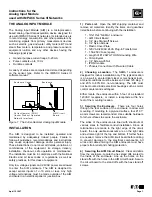
Chapter 2
Additive Error Reduction
©
National Instruments Corporation
2-11
Related Functions
balance()
,
truncate()
,
redschur()
,
mreduce()
truncate( )
SysR = truncate(Sys,nsr,{VD,VA})
The
truncate( )
function reduces a system
Sys
by retaining the first
nsr
states and throwing away the rest to form a system
SysR
.
If for
Sys
one has,
the reduced order system (in both continuous-time and discrete-time cases)
is defined by
A
11
,
B
1
,
C
1
, and D. If
Sys
is balanced, then
SysR
is an
approximation of
Sys
achieving a certain error bound.
truncate( )
may
well be used after an initial application of
balmoore( )
to further reduce
a system should a larger approximation error be tolerable. Alternatively, it
may be used after an initial application of
balance( )
or
redschur( )
.
If
Sys
was calculated from
redschur( )
and
VA,VD
were posed as
arguments, then
SysR
is calculated as in
redschur( )
(refer to the
section).
truncate( )
should be contrasted with
mreduce( )
, which achieves a
reduction through a singular perturbation calculation. If
Sys
is balanced,
the same error bound formulas apply (though not necessarily the same
errors),
truncate( )
always ensures exact matching at s =
∞
(in the
continuous-time case), or exacting matching of the first impulse response
coefficient D (in the discrete-time case), while
mreduce( )
ensures
matching of DC gains for
Sys
and
SysR
in both the continuous-time and
discrete-time case. For a additional information about the
truncate( )
function, refer to the
Xmath Help
.
Related Functions
balance()
,
balmoore()
,
redschur()
,
mreduce()
A
A
11
A
12
A
21
A
22
=
B
B
1
B
2
=
C
C
1
C
2
=
















































